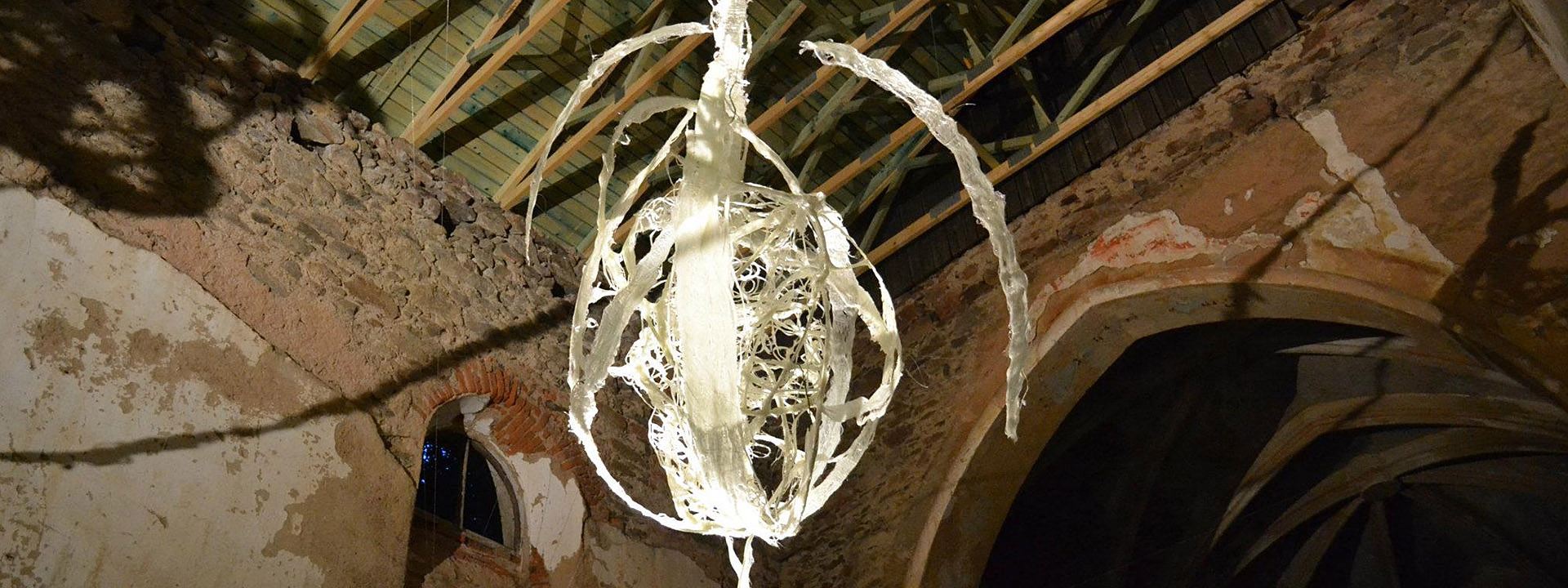
Land Art – Pendulum (2021)
The Pendulum is located near the restored Church of St Nicholas in Šitboř near Poběžovice, in the Domažlice region. This connection of the Pendulum, as well as its physical form, to this place is not incidental. The life oscillation and its sway between its poles, or life and death, is linked to the history that led to the demise and restoration of the church, but also to the personality and work of John of Šitboř, “Ploughman and Death”, where he dealt with such dialogue between death and life. It is about the sway of life, transformation, destruction and renewal, and constant oscillation, which we observe ever more strongly. In the form of a Pendulum, simplicity is applied, leading to liberation from superfluous thoughts and concentration on peace in spiritual meditation.
Author: Daniel Doležal, Sculpture and Space studio
Land Art – Tree Trunks (2020)
Implementation of a large artistic composition of hollowed-out crawl tunnel tree trunks located in a public, freely accessible area near the Švihov Water Castle near Klatovy. The resulting work of art created a motif in this locality, which encourages the discovery and perception of nature and material through an object that can be touched and naturally included in games or relaxation near a historical monument. Due to the size of the implemented work, teachers and students of the Sculpture and Space studio participated in its creation according to the design of late Professor Jiří Beránek and Associate Professor Benedikt Tolar.
Land Art – Carousel (2019)
The Carousel land art work near Boněnov is a paraphrase of the original torture wheel used in the Middle Ages. On the subject of atavism, the author chose the simplest expression – witchcraft. Various social groups in history have attempted to remove natural sciences from human life. Whether for scientific or religious reasons, natural healing was viewed in a bad light and its followers were, in isolated cases, executed. Witches represented the group that was executed most frequently. In modern times, increasingly more people are turning to alternative and natural ways of life (including healing and herbalism). The artwork aims to express this turning point and abandonment of the old practices by simplifying the previously mentioned execution wheel. Within the work, it became an object expressing the overcoming of old hatreds on the site of the former gallows hill. The Carousel no longer serves as a punishment object, but as a reminder of how far we as humankind have come to recognise nature properties.
Author – Hugo Wirth, Sculpture and Space studio
Land Art – Automobile (2018)
The object consists of a wooden stake, taut strings and a sound box. Hitting the string causes periodic vortices that vibrate the string, which then creates sound. The pitch, i.e., the vibration speed (frequency), is caused by the wind speed. The length and thickness of the string determines the key in which the string plays. The sound of the string vibrates the string in the same key. “Automobile” is the implementation of fifteen such objects in the landscape, specifically in a meadow near the Chalupy village near Zemětice in the Pilsen Region.
Author – Richard Fahrner, Sculpture and Space studio
Land Art – What I See Is No Longer Here (2018)
The landscape is a neural network, in which the individual points arise and sink. Relations between them sometimes disappear, but at other times they just sleep for a long time, and it is not known whether something or someone will sometimes wake them up. The sculpture design envisages its location in the dilapidated Baroque Vranov farm near Rabštejn. The sculpture with the land art principles consists of a central stone that fell from the sky into an old barn and, with its higher message, turned the roof upside down.
Author – Jakub Šik, Sculpture and Space studio
Land Art – Defunct and Endangered Churches (2012-2015)
The Land Art project was created within the Sculpture and Space studio of late Professor Jiří Beránek during the 2011/2012 school year. Its aim was to draw attention to the importance of churches as spiritual centres in the past, but also today. The purpose of the project is not, nor can be, the complete renovation of these buildings. The very number of these deliberately destroyed buildings is already dreadful, and their reconstruction is unrealistic. “However, their significance still lies in something else. Despite their sad fate, they preserve memory. The memory of the place as a spiritual centre, as a gathering point for people who are able to think about what goes beyond their capabilities,” said Prof. Jiří Beránek.
The project authors not only want to draw the attention of students, but also of the general public, to the problem of abandoned and destroyed mainly ecclesiastical buildings of the Czech border regions while, at the same time, offering students an interesting and current and really live theme. Prof. Beránek, in cooperation with architect Jan Soukup, selected several churches where students elaborated designs for land art compositions as part of their final and bachelor's theses. As part of the close cooperation of the Europen Capital of Culture Pilsen 2015, the Pilsen region, and the Ladislav Sutnar Faculty of Design and Art, University of West Bohemia in Pilsen, an idea was created to implement the best of these projects and to start building the Rediscovering the Cultural Landscape project. This created an excellent opportunity for students to try to implement their own work and gain valuable experience.

